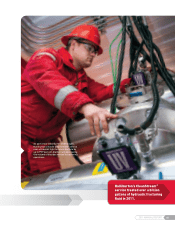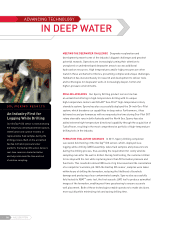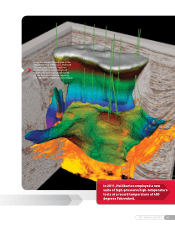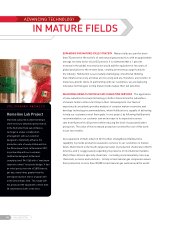Halliburton 2011 Annual Report Download - page 17
Download and view the complete annual report
Please find page 17 of the 2011 Halliburton annual report below. You can navigate through the pages in the report by either clicking on the pages listed below, or by using the keyword search tool below to find specific information within the annual report.2
Markets and competition
We are one of the world’ s largest diversified energy services companies. Our services and
products are sold in highly competitive markets throughout the world. Competitive factors impacting sales
of our services and products include:
- price;
- service delivery (including the ability to deliver services and products on an “as needed,
where needed” basis);
- health, safety, and environmental standards and practices;
- service quality;
- global talent retention;
- understanding of the geological characteristics of the hydrocarbon reservoir;
- product quality;
- warranty; and
- technical proficiency.
We conduct business worldwide in approximately 80 countries. The business operations of our
divisions are organized around four primary geographic regions: North America, Latin America,
Europe/Africa/CIS, and Middle East/Asia. In 2011, based on the location of services provided and products
sold, 55% of our consolidated revenue was from the United States. In 2010 and 2009, 46% and 36% of our
consolidated revenue was from the United States. No other country accounted for more than 10% of our
consolidated revenue during these periods. See “Management’ s Discussion and Analysis of Financial
Condition and Results of Operations – Business Environment and Results of Operations” and Note 2 to the
consolidated financial statements for additional financial information about geographic operations in the
last three years. Because the markets for our services and products are vast and cross numerous geographic
lines, a meaningful estimate of the total number of competitors cannot be made. The industries we serve are
highly competitive, and we have many substantial competitors. Most of our services and products are
marketed through our servicing and sales organizations.
Operations in some countries may be adversely affected by unsettled political conditions, acts of
terrorism, civil unrest, expropriation or other governmental actions, foreign currency exchange restrictions,
and highly inflationary currencies. We believe the geographic diversification of our business activities
reduces the risk that loss of operations in any one country, other than the United States, would be material
to the conduct of our operations taken as a whole.
Information regarding our exposure to foreign currency fluctuations, risk concentration, and
financial instruments used to minimize risk is included in “Management’ s Discussion and Analysis of
Financial Condition and Results of Operations – Financial Instrument Market Risk” and in Note 12 to the
consolidated financial statements.
Customers
Our revenue from continuing operations during the past three years was derived from the sale of
services and products to the energy industry. No customer represented more than 10% of consolidated
revenue in any period presented.
Raw materials
Raw materials essential to our business are normally readily available. Market conditions can
trigger constraints in the supply of certain raw materials, such as gel, proppants, and hydrochloric acid. We
are always seeking ways to ensure the availability of resources, as well as manage costs of raw materials.
Our procurement department uses our size and buying power to ensure that we have access to key materials
at competitive prices.
























